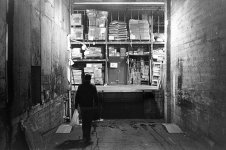rcoder
Member
Sorry if this has been covered here before, but I just thought I'd chime in for anyone who hasn't already heard about it: you really can develop B/W film in coffee!
The film I used was probably almost half as old as I am -- it was bulk-loaded by a friend in his last photography class almost 10 years ago, and god only knows how long it had sat on a shelf before that. We also used the 'Caffenol C' variant of the developer mix, which adds a pinch of Vitamin C to the usual coffee and washing soda recipe as an accelerator.
Regardless, I'm pretty happy with the results, considering we had almost no real control of dilution rates or temperature, (it was all done in my kitchen, using guesstimated measurements and timing) and given that our fixer was a 1:4 dilution of no-name aquarium de-chlorinator which we guess (it would appear correctly) was mostly sodium thiosulfate, a.k.a. "hypo".
Anyway, it was cheap, fun, and about as non-toxic as I think film developing can get. I think I'm going to see how well cheapo store-brand C41 holds up to similar treatment next -- B/W film is just getting too hard to track down.
(see the rest on flickr)
The film I used was probably almost half as old as I am -- it was bulk-loaded by a friend in his last photography class almost 10 years ago, and god only knows how long it had sat on a shelf before that. We also used the 'Caffenol C' variant of the developer mix, which adds a pinch of Vitamin C to the usual coffee and washing soda recipe as an accelerator.
Regardless, I'm pretty happy with the results, considering we had almost no real control of dilution rates or temperature, (it was all done in my kitchen, using guesstimated measurements and timing) and given that our fixer was a 1:4 dilution of no-name aquarium de-chlorinator which we guess (it would appear correctly) was mostly sodium thiosulfate, a.k.a. "hypo".
Anyway, it was cheap, fun, and about as non-toxic as I think film developing can get. I think I'm going to see how well cheapo store-brand C41 holds up to similar treatment next -- B/W film is just getting too hard to track down.
(see the rest on flickr)





